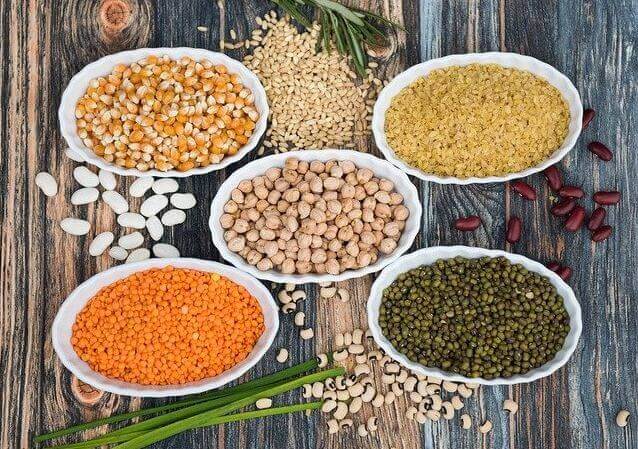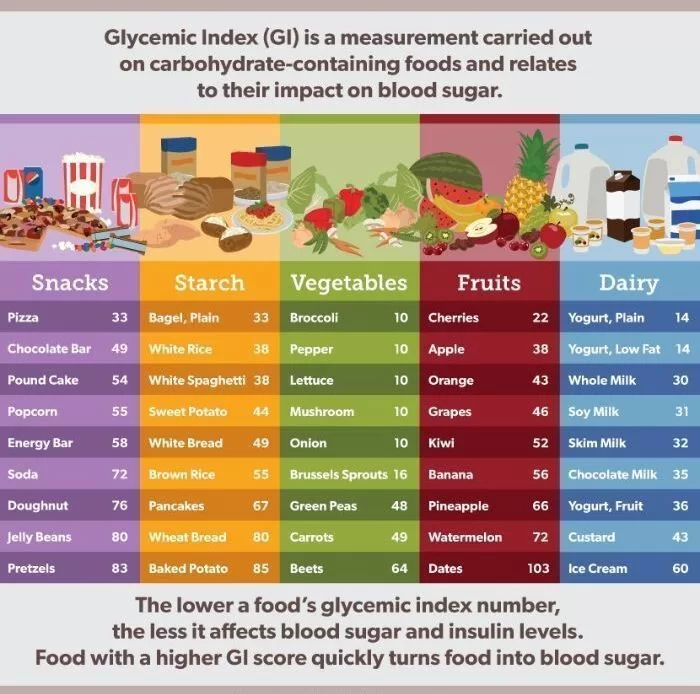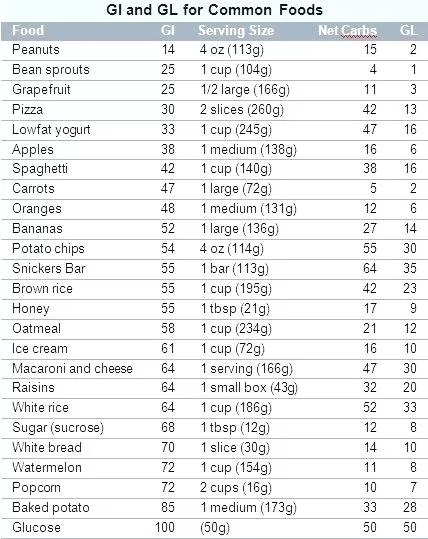The glycemic index (GI) is a measure of how quickly carbohydrates in a particular food raise blood sugar levels compared to pure glucose (which has a GI value of 100). It is a scale that ranges from 0 to 100, with foods that have a high GI causing a rapid rise in blood sugar levels, while foods that have a low GI cause a slower and more gradual rise.
The GI of a food depends on a number of factors, including the type of carbohydrate present, its chemical structure, and how it is cooked or processed. For example, simple carbohydrates, such as refined sugars, are rapidly absorbed and have a high GI value, while complex carbohydrates, such as those found in whole grains and vegetables, take longer to digest and have a lower GI value.
relationship between glycemic index and diabetes
The relationship between glycemic index and diabetes is important because people with diabetes have a reduced ability to regulate their blood sugar levels. In people with type 1 diabetes, the body does not produce enough insulin, a hormone that regulates blood sugar levels. In people with type 2 diabetes, the body becomes resistant to insulin over time, meaning that blood sugar levels can become elevated.
Eating foods with a high glycemic index can cause a rapid rise in blood sugar levels, which can be dangerous for people with diabetes. Over time, this can lead to complications such as nerve damage, kidney damage, and cardiovascular disease.

Therefore, it is important for people with diabetes to manage their blood sugar levels by choosing foods with a lower glycemic index. This includes eating plenty of whole grains, fruits, vegetables, and legumes, which have a lower GI value and provide more sustained energy than foods high in refined sugars and simple carbohydrates.
Overall, understanding the glycemic index can help people with diabetes make better food choices to manage their blood sugar levels and reduce the risk of complications associated with the condition.
what are low, medium, and high G I and their range
The glycemic index (GI) is a scale used to measure how quickly a food raises blood sugar levels after it is consumed. Here are the general ranges for low, medium, and high GI foods, along with examples:
Low GI foods (55 or less):
These foods are digested and absorbed slowly, resulting in a gradual rise in blood sugar levels. Examples of low GI foods include most fruits and vegetables, whole grains, legumes, nuts, and seeds.
Medium GI foods (56 to 69):
These foods are digested and absorbed at a moderate rate, resulting in a relatively moderate rise in blood sugar levels. Examples of medium GI foods include some fruits such as bananas and mangoes, some types of rice, and some types of bread.
High GI foods (70 or higher):
These foods are digested and absorbed quickly, resulting in a rapid rise in blood sugar levels. Examples of high GI foods include sugary drinks, processed snacks such as candy and cakes, white bread, and white rice.
It is important to note that the GI value of a food can vary depending on factors such as cooking method, processing, ripeness, and individual differences in digestion and metabolism. It is also important to consider the overall nutrient content of food, as well as portion size when making dietary choices. A healthcare professional or a registered dietitian can help to develop an individualized diet plan that takes into account individual needs and preferences.
Low glycemic vegetables that a diabetic patient should consume
There are many low-glycemic vegetables that are suitable for people with diabetes to consume. Here are some examples:
- Leafy greens: Leafy greens such as spinach, kale, and lettuce are low in carbohydrates and have a very low glycemic index. They are also rich in nutrients and antioxidants.
- Cruciferous vegetables: Vegetables in the cruciferous family, such as broccoli, cauliflower, and Brussels sprouts, are high in fiber and low in carbohydrates. They also have a low glycemic index and are rich in vitamins and minerals.
- Asparagus: Asparagus is a low-glycemic vegetable that is high in fiber, vitamins, and antioxidants. It is also a good source of folate, which is important for people with diabetes.
- Tomatoes: Tomatoes are a low-glycemic vegetable that is high in antioxidants and vitamins. They are also a good source of lycopene, which has been shown to help lower the risk of heart disease.
- Bell peppers: Bell peppers are low in carbohydrates and have a low glycemic index. They are also high in vitamins and antioxidants.
- Cucumbers: Cucumbers are a low-glycemic vegetable that is high in water and fiber. They are also a good source of vitamin K and potassium.
- Zucchini: Zucchini is a low-glycemic vegetable that is high in fiber and antioxidants. It is also a good source of vitamin C and potassium.
Overall, incorporating a variety of low-glycemic vegetables into your diet can help you manage your blood sugar levels and reduce the risk of complications associated with diabetes. It is important to talk to your doctor or a registered dietitian to determine the best diet plan for your individual needs.
low glycemic fruits that a diabetic patient should consume
There are many low-glycemic fruits that are suitable for people with diabetes to consume. Here are some examples:
- Berries: Berries such as strawberries, raspberries, blackberries, and blueberries are low in carbohydrates and high in fiber and antioxidants. They also have a low glycemic index.
- Apples: Apples are low-glycemic fruit that is high in fiber and vitamins. They also contain antioxidants and have been shown to have beneficial effects on heart health.
- Grapefruit: Grapefruit is a low-glycemic fruit that is high in vitamin C and fiber. It also contains antioxidants and has been shown to have beneficial effects on blood pressure and cholesterol levels.
- Cherries: Cherries are low-glycemic fruit that is high in antioxidants and anti-inflammatory compounds. They also have been shown to have beneficial effects on sleep and exercise recovery.
- Peaches: Peaches are a low-glycemic fruit that is high in fiber and vitamins. They also contain antioxidants and have been shown to have beneficial effects on heart health.
- Plums: Plums are a low-glycemic fruit that is high in fiber and vitamins. They also contain antioxidants and have been shown to have beneficial effects on bone health.
- Kiwi: Kiwi is a low-glycemic fruit that is high in vitamin C, fiber, and antioxidants. It has also been shown to have beneficial effects on digestive health and immune function.
The GI database that has been published does not contain an exhaustive list of foods. Instead, it is a collection of foods that have been subjected to scientific investigation. It’s possible that the database may not include a lot of wholesome foods that have low GI levels.
There are also highly processed items on the list, which may have a lower nutritional value than those that have not been processed. In addition, there is a possibility that some foods with low GI ratings are not very rich in nutrients.
low glycemic gram and pulses that a diabetic patient should consume
Grams and pulses, also known as legumes, are good sources of protein, fiber, vitamins, and minerals. They are also low in glycemic index, making them a great food choice for people with diabetes. Here are some examples of low-glycemic legumes:
- Lentils: Lentils are low-glycemic legumes that are high in fiber, protein, and iron. They are also a good source of folate and have been shown to have beneficial effects on heart health.
- Chickpeas: Chickpeas, also known as garbanzo beans, are a low-glycemic legume that is high in fiber, protein, and vitamins. They are also a good source of minerals such as iron, magnesium, and potassium.
- Kidney beans: Kidney beans are a low-glycemic legume that is high in fiber, protein, and antioxidants. They are also a good source of minerals such as iron, magnesium, and potassium.
- Black beans: Black beans are a low-glycemic legume that is high in fiber, protein, and antioxidants. They are also a good source of minerals such as iron, magnesium, and potassium.
- Lima beans: Lima beans are a low-glycemic legume that is high in fiber, protein, and iron. They are also a good source of minerals such as magnesium and potassium.
- Peas: Peas are low-glycemic legumes that are high in fiber, protein, and vitamins. They are also a good source of minerals such as iron, magnesium, and potassium.
- Soybeans: Soybeans are low-glycemic legumes that are high in protein, fiber, and vitamins. They are also a good source of minerals such as iron, magnesium, and potassium.
Overall, incorporating a variety of low-glycemic legumes into your diet can help you manage your blood sugar levels and reduce the risk of complications associated with diabetes. However, there is no correlation between the GI number and any other nutritional information. Cantaloupe, for instance, has a GI value that ranges from medium to high and a GL score that falls somewhere in the middle.
On the other hand, it is an excellent resource for vitamin C, beta-carotene, and a number of other vital elements. Both the GI value and the GL value of whole milk are rather low. Yet it has a lot of calories and fats in it. So, it is possible that it is not a great option for reducing or managing one’s weight.

low-glycemic dairy products that a diabetic patient should consume
Dairy products are a good source of protein, calcium, and vitamin D, but they can also be high in carbohydrates and have a significant impact on blood sugar levels. Here are some examples of low-glycemic dairy products that are suitable for people with diabetes:
- Greek yogurt: Greek yogurt is a low-glycemic dairy product that is high in protein and calcium. It also has a lower carbohydrate content compared to regular yogurt, making it a good choice for people with diabetes.
- Cottage cheese: Cottage cheese is a low-glycemic dairy product that is high in protein and calcium. It is also lower in carbohydrates compared to other types of cheese.
- Hard cheeses: Hard cheeses such as cheddar, Parmesan, and Swiss are low in carbohydrates and have a low glycemic index. They are also a good source of protein and calcium.
- Skim milk: Skim milk is a low-glycemic dairy product that is a good source of protein, calcium, and vitamin D. It also has a lower carbohydrate content compared to whole milk.
- Soy milk: Soy milk is a low-glycemic dairy alternative that is a good source of protein, calcium, and vitamin D. It also has a lower carbohydrate content compared to cow’s milk.
It is important to keep in mind that not all dairy products are created equal and some may have a higher impact on blood sugar levels. It is recommended to choose low-fat or fat-free dairy products and avoid products with added sugars. It is also important to talk to your doctor or a registered dietitian to determine the best diet plan for your individual needs.
Are there any risk factors for consuming low-G I Foods
While low glycemic index (GI) foods are generally considered safe and beneficial for people with diabetes, there are some potential risk factors to keep in mind:
Inadequate nutrient intake:
Some people who follow a strict low-GI diet may consume inadequate amounts of certain nutrients, such as fiber, vitamins, and minerals, that are found in high-GI foods. It is important to ensure that your diet is balanced and provides all the necessary nutrients for good health.
Increased fat intake:
Some low GI foods, such as processed foods that are marketed as “low GI,” may be high in fat and calories. Consuming these foods in excess can contribute to weight gain and increase the risk of other health problems, such as heart disease.
Cost and availability:
Some low-GI foods, such as fresh fruits and vegetables, maybe more expensive or difficult to access in certain areas. This can make it challenging to maintain a low GI diet, especially for people with limited financial resources or living in food deserts.
Individual variation:
The glycemic index can vary depending on factors such as the cooking method, ripeness of the food, and individual differences in digestion and metabolism. This means that the GI value of a particular food may not always accurately reflect its impact on blood sugar levels in all people.
Overall, low GI foods can be a healthy and beneficial choice for people with diabetes, but it is important to consider individual needs and preferences when making dietary choices. There are a variety of elements that determine a food item’s glycemic index (GI). The manner in which the food is produced as well as the manner in which it is processed is important. Moreover, the GI levels of the same meals might vary quite a little from one another. So, it is possible that the figures are not appropriate for all food options.
What is meant by a balanced G I diet
A balanced glycemic index (GI) diet is a way of eating that focuses on consuming a variety of foods that have a balanced effect on blood sugar levels. The goal of a balanced GI diet is to prevent blood sugar spikes and dips that can contribute to diabetes, weight gain, and other health problems.
In a balanced GI diet, the emphasis is on choosing foods that have a moderate or low GI value, such as whole grains, fruits, vegetables, lean protein sources, and healthy fats. These foods are digested and absorbed more slowly, resulting in a slower and more steady release of glucose into the bloodstream.

In addition to focusing on low GI foods, a balanced GI diet also emphasizes portion control, regular meal timing, and choosing a variety of foods from all food groups to ensure adequate nutrient intake. It is important to consume enough fiber, vitamins, and minerals to support good health, while also controlling carbohydrate intake to prevent blood sugar spikes.
It is recommended to consult with a healthcare professional or registered dietitian to determine the best balanced GI diet plan for your individual needs, as dietary requirements can vary depending on factors such as age, sex, activity level, and overall health status.
Disclaimer: The author’s views are his or her own. The facts and opinions in the article have been taken from various articles and commentaries available in the online media, and Eastside Writers does not take any responsibility or obligation for them.
This website’s information is provided for educational purposes only; it is not meant to be a source of personalized medical advice. If you have any concerns about a medical problem, you should talk to your doctor or another experienced healthcare professional. Never dismiss or put off obtaining competent medical advice because of something you have read on this website. No goods are suggested or endorsed by Eastside Writers.
Note: Contact our writers at www.eastsidewriters.com for writing Blogs/Articles on any niche. We have experts in various domains, from Technology to Finance and from Spirituality to Lifestyle and Entertainment.







Pingback: The Incredible Benefits of Regular Exercise: Why You Should Make It a Priority" - Eastside Writers
Pingback: Shedding Pounds for a Healthier You: Inspiring Reasons And 12 Tips to Reduce Your Weight - Eastside Writers
Pingback: The Mysteries of Apple Cider Vinegar: A Secret Elixir for Health and Wellness - Eastside Writers
Pingback: The Power of Pomegranate -This Superfood Can Help You Lose Weight - Eastside Writers
Pingback: Unleashing Your Energy Reservoir: A Guide to Staying Energetic Under All Circumstances - Eastside Writers